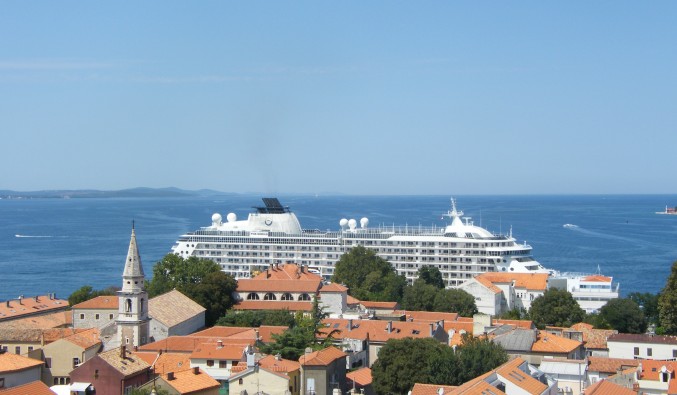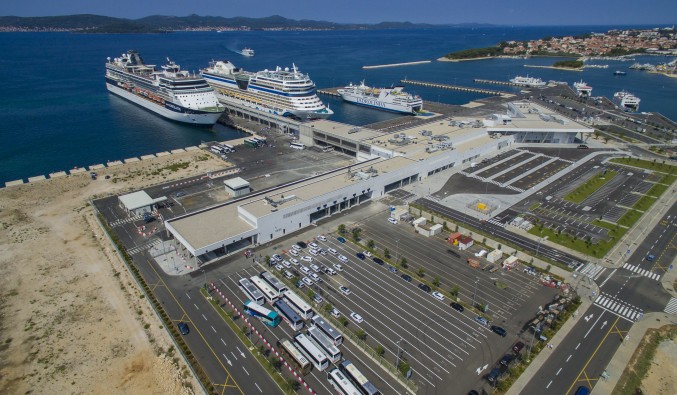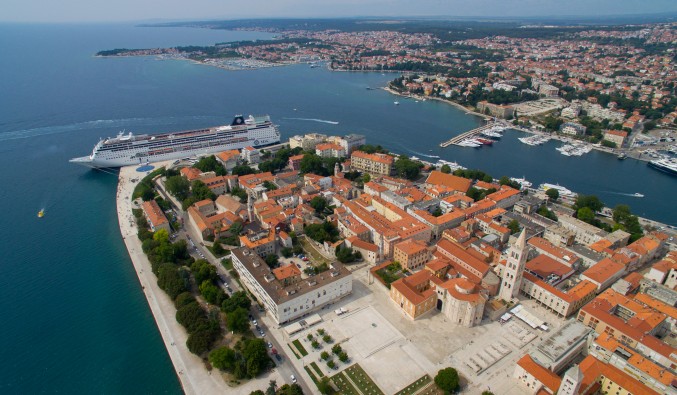Description
Located in the region of Dalmatia, Zadar overlooks the Adriatic and is an important tourist enclave. With regard to traffic, Zadar is the center of the region that links the North and the South of Croatia by the most modern highway in Europe. Zadar is located halfway between Venice and Dubrovnick. It was always an important transit port. Nowadays, the annual passenger traffic is 2.6 million people and 465,000 vehicles, which places it among the ports with the most movement in the Mediterranean.
The port of Zadar is registering an increase in cruise ship visits. Thanks to its geographical location and the temperate climate of the Mediterranean – and the fact that there are almost no flight cancellations at its airport – as well as to the airport location only between one and two hours from all European capitals, as well as its heritage and historical wealth, the port of Zadar has become an alternative to more popular and popular destinations in the area.
The Port Authority of Zadar was founded in 1997 by the decision of the Government of the Croatian Republic as founded in 1997 by decision of the Governemnt of the Croatian Republic as and non governamental underneath the protectorate of the Law of Ports and Maritime Domine.
Main activities of the port of Zadar

-Address, development and use of the new port of Zadar which open international port, that due to its size and imortance was nominates as the Special Economical Interest for the Croatian Republic
-Address of all the docks under the jurisdiction of the PZA.
–To grant concessions to port activities prescribed in the technical and technological conditions for public procurement procedures.
Zadar´s cruises port
Located in the city centre, its location facilitates direct access to the commercial and tourist area and other monumental resources. Passengers can move from the port quickly and easily to the city center because the walking distance is five minutes.

The Government of the Republic of Croatia together with the Ministry of Sea, Tourism, Transport and Development, represented by the Port Authority of Zadar, considered that implementing the construction project for the new ferry terminal was a priority.
The port of Zadar has four docks in its jurisdiction: Old City Port, Cargo Port, New Ferry and Cruise Port and Fishing Port Kali.
Port of cruises and ferries of Gazenica
The Zadar ferry terminal is the main access of the Croatian islands to the city of Zadar. It is second in the ranking by number of passengers in the Adriatic after the port of Split. It also has an important role as a connection between the ferry terminals that are located along the Croatian coast and between the Adriatic and Mediterranean coasts.

The port of Gazenica has a very important role for the development of tourism, which is the key sector in the Croatian economy and includes both cruise ships and passengers visiting Croatia by sea.
The relocation of the Zadar ferry port in the Gazenica area, 3.5 km south of the city of Zadar, has been considered a priority project for the Croatian government. This project has allowed the increase in traffic by adding additional berths that can now accommodate larger ferries and cruises, as well as rolling cargo vessels.
The new port is directly connected to the new motorway network with direct and fast access to Zadar airport, Zagreb and the rest of Croatia and Central Europe through its network of roads and highways.

The new ferry and cruise port of Gazenica was built creating the necessary area on land and adequate draft in the maritime zone, filling part of the dock and the dock. Access roads and parking were also built. The terminal building will be equipped with everything necessary to establish an operational and modern terminal.
The new cruise terminal Gazenica Port
The Port of Zadar carried out the construction of the central building of the cruise terminal that will include parking and all the infrastructure associated with the building. In the central building that is designed as a two-story building, the domestic, international and cruise ferry traffic will be managed. The main idea is that the building reflects functionality.
The terminal is divided into sections between the central terminal of the building for domestic traffic and the international ferry terminal and cruise terminals. The building has 119 parking spaces to which 386 have been added over time to a total of 458 spaces, including spaces for people with reduced mobility.
This building will be working in April 2019
What not to miss in Zadar if you do a cruise stop

Zadar is one of the oldest cities and the fifth city in Croatia. It is located in the center of the Adriatic and constitutes the urban, administrative, economic, cultural and political center of the center of Dalmatia. The region of Dalmatia has 180,000 inhabitants.
Frequently compared to Venice and Dubrovnik, Zadar is irresistible to all those who admire historical and cultural monuments, artists, tourists and citizens. Zadar is a monument surrounded by archaeological treasures and rich monuments of medieval times, the Renaissance and contemporary architecture, as the first marine organ in the world.
In the city of Zadar, centered around the Roman Forum and surrounded by monumental walls, is the Archaeological Museum founded in 1832 – it is the second oldest in this part of Europe. The archaeological remains of the Zadar region, from prehistoric times, classical and ancient to the Middle Ages, are preserved in the three sections of the museum. It is the oldest university city for Croats and was founded in 1936. The Department of Humanities has 19 departments. It is also the birthplace of the first Croatian novel as well as newspapers in Croatian.

Hundreds of turbulent years, of destruction, have left scars but also numerous legacies that make Zadar today a city with a lot of courage. Numerous churches and cultural monuments have been preserved in historical and artistic periods. All styles can be seen, from Romanesque to medieval and contemporary architecture.
In the heart of the city there are up to 70 historical monuments. Other enclaves that surround the district have more than 600 cultural monuments.
Zadar appeared for the first time in history in the 4th century AD. as a settlement of the Illyrian tribe of the Liburnians. The name ‘Jader’ was mentioned throughout history and changed to Idassa (of Greek origin), Jadera (of Roman origin), Diadora, Zara (during the Venetian period and later Italian) until what is today the name of Zadar
After the year 59 a.d.C. Zadar became a Roman municipality and in the year 48 a.d.C. it became a colony of Roman citizens. During the Roman Empire, Zadar acquired the characteristics of a city with a road connection and a central square – the Forum – next to an elevated Capitol with a temple. In the 7th century, Zadar became the capital of the Byzantine province of Dalmatia. At the beginning of the 9th century, Zadar was named after Bishop Donatus and the Byzantine leader Paulus. At that time the church was erected in the Roman Forum of the Holy Trinity, nowadays San Donatus, which is the symbol of the city.
The settlement of Croatians in Zadar marked the tenth century. The church of St. Mary, the church of Chrysogonus and the cathedral of St. Anastasia have been preserved since the Romanesque period. In 1202 the city was conquered and burned by the Crusades and the Venetians. The first Gothic church of Dalmatia, St. Francis and St. Dominic – which were built after that time – as well as the golden and silver sarcophagus of San Simeon must be mentioned among the treasures of this period.
In the fifteenth and sixteenth century the first writings were recorded in the national language -Petar Zoranic, Brna Krnaurtic, Sime Budinic, Jerolim Vidulic …-. The Austrians in 1797 took care of the government of Zadar after the Venetians. In 1806 and until 1813 it was the French who reigned. After this reign, Zadar remained under the Austrian Empire until 1918.
With the Treaty of Rapallo, Zadar was again under Italian rule. After the Second World War it was annexed to Croatia within the framework of the Federation of Yugoslavia. Zadar and its surroundings were attacked in 1991 by Serbia. The Serbian rebels managed to conquer and destroy the city and its region by attacking with a destructive force never seen before. Zadar was controlled by the rebels and devastated. The city was the target of repeated attacks and the cultural heritage of the Zadar was seriously damaged.
Zadar is a city rich in spiritual and cultural matters as well as a tourist entity created in the present. It was created around a Roman forum, within well-preserved walls and is full of ancient monuments. Filled with archives, museums and libraries, Zadar retains a literary treasure within the oldest University in Croatia.
Zadar is a city protected by four guardian saints: Zoilo, Simeon, Chrysogonus and Anastasia.
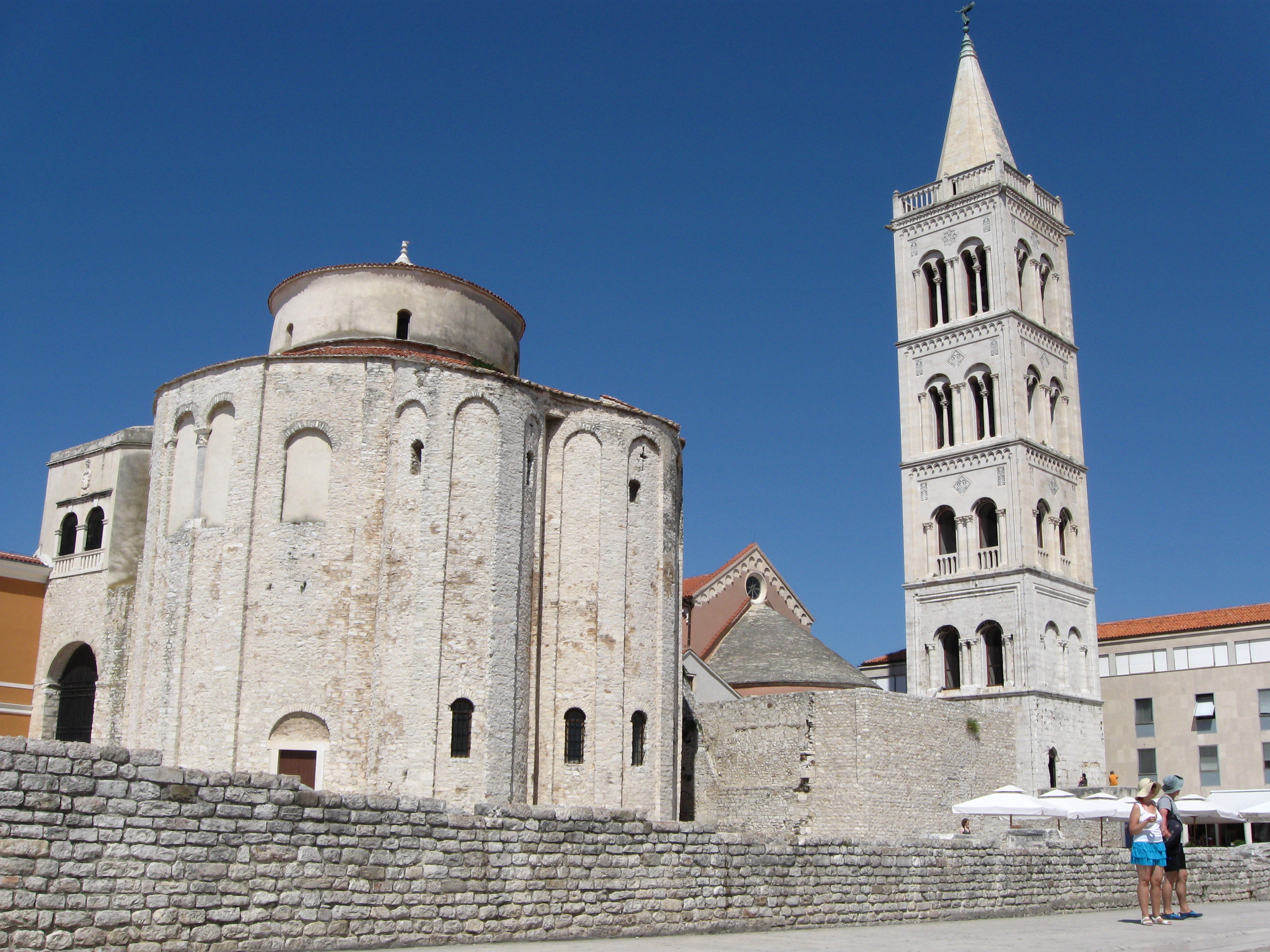
The walls of Zadar, a World Heritage Site by UNESCO
Zadar was the military and administrative center of the Adriatic and part of the Republic of Venice and the navigation center between Venice, Corfu and Greece. It is located on a peninsula surrounded by certified walls overlooking a fort. The defense of the city in the peninsula preserves structures and walls that were preserved in time and are considered a masterpiece of the High Renaissance.
The stopover in the cruise port of Zadar allows travelers to see such emblematic monuments as the Church of San Donato and the Forum of the 1st century BC. C.
In Zadar is the Cathedral of Santa Anastasia and one of the most curious monuments in the world, the marine organ. An architectural feat that produces music created by the waters. Accompanied by the monument Welcome to the Sun they are one of the artistic wonders of the country.
The organ of Zadar is part of its coast and is composed of several stairs that descend to the sea level and cover approximately 70 meters of coastline. The lowest is located at the level of the bank and the organ consists of 35 tubes of different lengths and diameters. The whistles feature LA-BIUMS that play 7 strings of 5 tones. On the channel there are perforated stone stairs through which the sound of the air pushed by the sea comes out. This place is a mixture of human creation and marine energy, intended for relaxation and conversation while listening to the harmonies of the sea
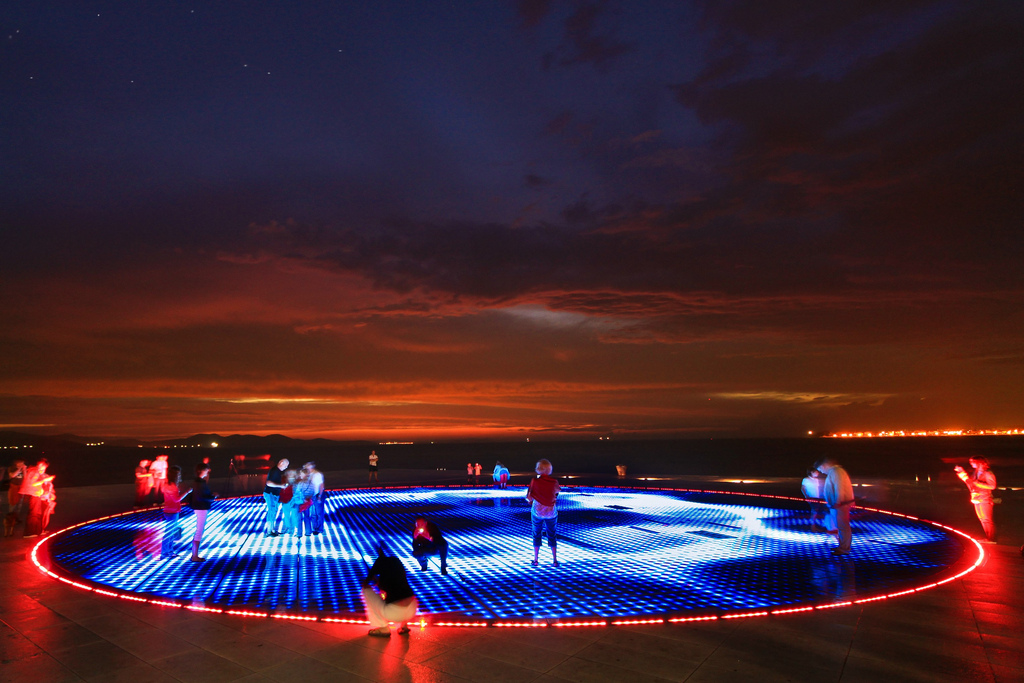
The sun salutation is one of the richest and most urban facilities at the end of the Zadar peninsula next to the famous Sea Organ. It is a space made by the same architect Nikola Basic. Saludo al Sol consists of 300 glass tiles made at the same level of the sea with a circular shape and 22 meters in diameter. Under the glass plates there are solar photovoltaic modules whose purpose is to communicate with lights what the sea organ does with sound, simultaneously with the rhythm of the waves and with the sunset or sunrise. The light elements installed in the circle light up, which produces a light show at the rhythm of the waves. It is a project that connects the use of renewable energies and was done in cooperation with Professor Maksim Klarin, of the Maritime School of Zadar.
The names of the saints to whom the churches of the area of the Zadar peninsula are dedicated have been engraved in the ring that surrounds the space dedicated to the Greeting to the Sun.
Another of the unique monuments in the world that the beautiful city of Zadar has is the Glass Museum of the Ancient Age.
The visit to Zadar is completed by tasting its delicious seafood cuisine and its lamb dishes and its famous Dalmatian wines. It is also known for its cured ham from Posedarje, salted with the sea.
A tour about Zadar
In addition to the medieval walls, museums and palaces and monuments with more than 3000 years of history, Zadar has a very attractive resource that is the Organ of the Sea, which allows you to greet the Sun from its circle of 22 meters in diameter.
Another essential resource in the visit during the cruise scale in Zadar is the Church of St. Donatus, symbol of the city of Zadar and one of the most famous monuments of Croatia. It dates from the Middle Ages, 9th century, it is a round, pre-Romanesque church, which was called the Church of the Holy Trinity until the 15th century. From then on I took the name of San Donato, the bishop who built it. The church was mentioned for the first time in the middle of the tenth century, in the documents of the Byzantine emperor Constantine VI Porphyrogennetos. Nowadays space is used for musical performances, due to its spectacular acoustics. They are called ‘the acoustic nights in San Donato’.
The Forum is another resource to visit in Zadar. Located in front of the church of St. Donatus and the Archbishop’s Palace, it is a municipal square from Roman times, built from the 1st century BC. until the third century AD Its measurements are 45 x 90 meters and represents a highly developed example of a complex forum and is one of the most important of the ancient cities of the Adriatic.
The inscription with the name of Augustus, pro-consul of Illyricum, Tanfil Vallee, sculpted in the well of the Forum testifies that the complex construction began in the second decade of the first century before Christ. The name of the Forum is given to all the main squares in the cities of the old Roman Empire where public life took place. Initially, at a distance of two meters from the Capitol and in the Southwest direction, there is a temple dedicated to Jupiter, Juno and Minerva, where a pillar that was called ‘The Pillar of Shame in the Middle Ages’ is preserved.
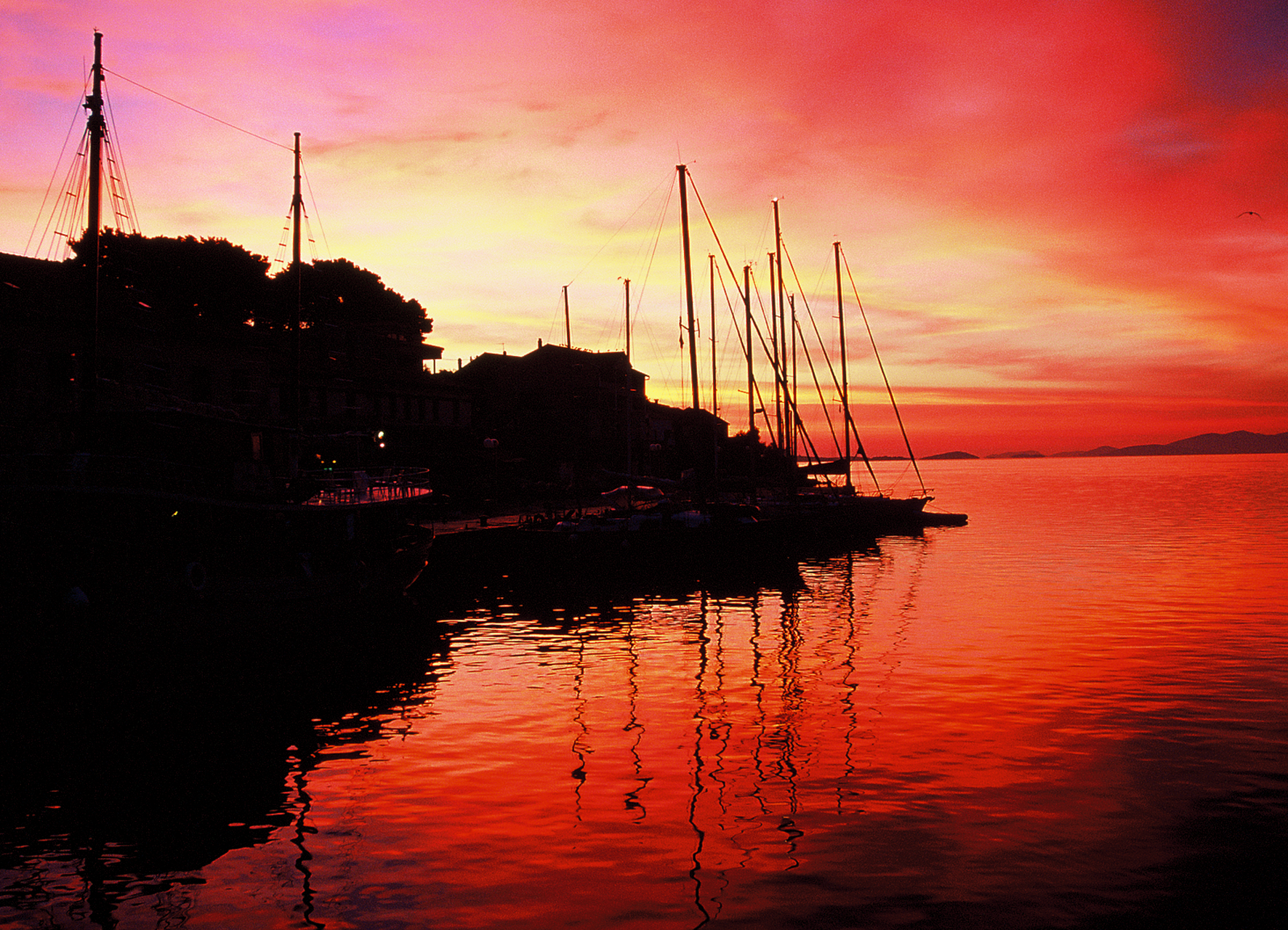
The Archaeological Museum of Zadar was founded in 1832 and has been considered the second of all Croatian museums. As a state museum, the institution covers the area of the District of Zadar and the islands of Pag and Rab. Within the museum there are different departments such as the Prehistoric, the Ancient, the Medieval and underwater archaeological units, as well as the archaeological collection of Nin, the library and the interior department. There are more than 100,000 remains that are displayed in the Archaeological Museum of Zadar from all historical periods.
One of the resources we can visit in Zadar is its permanent exhibition ‘The Gold and Silver of Zadar’, it is a permanent exhibition of religious art and one of the most valuable in Croatia. It is located in the structure of the Church of St. Mary and more specifically in the Monastery, property that was very affected during World War II. The exhibition was formed in 1972 but was initiated in 1951 by the Croatian writer Miroslav Krleza and transformed in 1976 into a permanent exhibition of ecclesiastical art in the Benedictine convent of St. Mary in Zadar. This is one of the most important buildings of the Croatian culture.
On one occasion, Krleza wrote in one of his essays and on the occasion of the exhibition that the treasures of Zadar were glorified there. The Gold and Silver of Zadar shine on a surface of about 1,200 square meters in 8 modern and well-equipped rooms, which include the interior of the old Croatian church of San Nediljica from the 11th century. Also included are manuscripts, sculptures, tapestries and embroidery. This is evidence of the rich past of Zadar between the eighth and eighteenth centuries, a city that was particularly important in the Middle Ages.
Joys, hopes, patience, suffering and faith in this tumultuous era in the history of this region are the display of chalices, sculptures, paintings and embroidery. This treasure without price is already preserved from the Benedictine nuns through the years, as well as during the war of patriotic defense. Some valuable pieces of the exhibition were made by the hands of the nuns. The charm and importance of these objects, among others, is that they were made by people from the area and also by unknown masters or who simply have some connection with the Zadar region. The permanent ecclesiastical art exhibition is of great cultural and religious value. All this is contained in a site and can only be seen in one of the major centers of Europe.
Pag´s island and the city of Nin

The island of Pag is 40 minutes away and is one of the largest Adriatic islands. It is the fifth largest island with 284.50 square kilometers. It has 270 kilometers of coastline and is one of the longest coasts of the Adriatic rich in bays, beaches and coves. The largest bay is Pag Bay, it is surrounded by 20 kilometers of beach. Pag is unique, due to its vegetation in which very particular trees are included. Then, Pag is the largest kingdom of rocky soil in the Adriatic where fine grass and aromatic sage grow. The island of Pag is perfect for the sheep. Due to all this, the well-known Pag cheese has a very special flavor.
The city of Nin is the oldest city in Croatia and is only 15 minutes away from Zadar. The city of Nin was a real and cultural center through Croatian history. This is testified by its monuments of the 8th and 9th century. In addition, it offers the possibility of tasting local and natural products such as cheese, bread or wine from the area.
In the vicinity of Zadar there are other tourist resources that are worth visiting during a long stopover or during a stay in the city for several days, such as its five National Parks: Palencia, Kornati, Plitvica, the Krka waterfalls and North Velebit .

